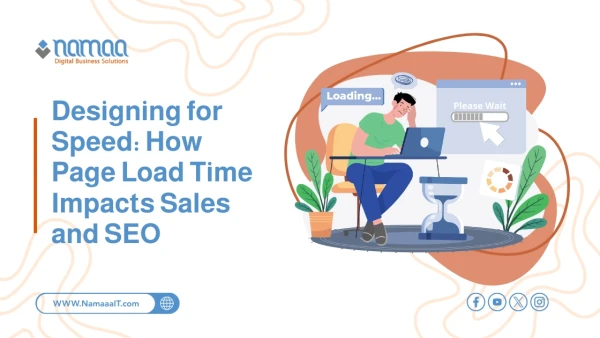Launching a New Website is Like Opening a Shop on a Busy Street
It’s not enough to just open the doors and wait for customers. To attract visitors from day one, your website must be visible and prominent in the places where people are searching. This is where Search Engine Optimization (SEO) comes in as a vital tool to ensure your site appears on the first pages of search engines.
Achieving this goal doesn’t depend on luck but on a well-thought-out strategy that begins from the moment the website is launched. From choosing the right keywords, to improving user experience, and creating valuable content—each step plays a role in boosting your site's rankings. In this article, we’ll review the essential steps to prepare your website to rank high in search results (SEO) from day one, setting you on the right path to digital success.
How to Prepare Your Website for SEO Success from Day One?
Choose a Domain Name and Site Structure That Supports SEO
The first step in building a search engine-friendly website starts with choosing a domain name that reflects the identity and niche of your website. Ideally, it should be short, memorable, and contain a relevant keyword if possible.
Next comes planning your site architecture. Keep your main pages logically structured and organize content into clear sections that are easy for both visitors and search engines to navigate.
This organization improves crawl and indexing rates by search engines and reduces bounce rates, increasing your chances of ranking higher from the beginning.
Write Custom Content That Matches the Searcher’s Intent
Every page on your website should serve a specific search intent. Don’t copy content from other sites—instead, write what sets you apart and provides real value to the reader. Use search intent analysis to determine what kind of content is needed: is the visitor looking for an explanation, a comparison, or a product?
Smartly include keywords in the title, the first paragraph, and subheadings. Use clear, simple language without exaggeration or fluff. Quality content from the start gives your site a strong push in search rankings and encourages visitors to engage and stay longer.
Improve Site Speed and User Experience from the Start
Site speed directly affects your search engine ranking. Ensure your website runs smoothly and doesn’t take too long to load—whether on mobile or desktop. Use tools like Google PageSpeed Insights to find technical issues and fix them before launching.
Also, make sure your site design is responsive, adapting to different screen sizes, and that navigation is intuitive. Excellent user experience doesn’t just satisfy visitors—it’s a positive signal to search engines, increasing your chances of ranking higher quickly and effectively.
Set Up Essential Pages That Build Trust with Search Engines
Launching a website without basic credibility pages like "About Us", "Contact Us", and "Privacy Policy" is a mistake. These pages don’t just help visitors, but also signal to search engines that your site is trustworthy and has a clear identity.
Make sure the content on these pages clearly represents your brand, contact methods, and user rights. Adding these pages from day one sets your site up for proper indexing and boosts your SEO chances, especially when competing with larger sites. Don’t forget to include these pages in your site footer to enhance internal linking and user experience.
Connect the Site to Webmaster Tools and Performance Analytics
After launching your website, you’ll need to track its performance and how users interact with your content. Connect it to tools like Google Search Console and Google Analytics as early as possible.
These tools provide valuable data like visit numbers, keywords driving traffic, and each page’s performance in search results. With this information, you can tweak content, fix underperforming pages, and continuously improve your SEO strategy.
Connecting to these tools from the start speeds up indexing and gives you full control over your site's growth in search results.
READ MORE: The Difference Between Website Design and Development
Create a Sitemap to Make Page Indexing Easier
A sitemap helps search engines discover your pages quickly and efficiently. This is especially important when launching a new website with multiple pages. By using a sitemap.xml file, you can tell search engines which pages to index and indicate the importance of each page.
Make sure to submit the sitemap to Google Search Console and link it in your robots.txt file. This simple process speeds up page appearance in search results and boosts early-stage SEO performance. Don’t rely solely on web crawlers to find your pages—guide them directly.
Optimize Images and Visual Elements for Better Speed and Performance
Heavy images slow down your website, and slower sites rank lower in search results. Compress images without losing quality, and use modern formats like WebP to reduce file size.
Name image files with relevant keywords and fill out the "alt" attribute with accurate descriptions, which also helps you appear in image search results. Using images in your content enhances its appeal and encourages user interaction. Optimizing visuals directly improves site engagement time, which gradually boosts SEO rankings.
Build Internal Links to Connect Your Content
It’s crucial to start building internal links between your pages from day one. This creates an interconnected network within your site. Internal links help users navigate easily and increase their time on site, while also helping search engines understand the content hierarchy and page priority.
For example, if you’re writing about “Website Design”, link it to another article on “User Experience Fundamentals”. Avoid excessive linking—focus on relevant, value-adding links that serve both the user and the page topic. A strong internal link structure boosts SEO naturally and efficiently.
Use Structured Data to Enhance Search Result Appearance
Structured data (like JSON-LD) helps search engines understand more about your content. You can specify the type of content—article, product, review, recipe, etc.
This data appears in search results as “rich snippets” such as star ratings, images, and reviews, which attract more clicks. Use tools like Google Rich Results Test to ensure the data is implemented correctly. Activating this feature from the start makes your site look more professional in search results and increases your chances of ranking high faster.
Set Up HTTPS Security Settings to Gain Search Engine Trust
Security is not optional—it’s essential for any site that wants to rank high. Using HTTPS is an official ranking factor by Google. In addition to boosting your SEO, an SSL certificate gives visitors a sense of trust—especially if you're collecting data or running an online store.
Make sure HTTPS is activated from the beginning and redirect all HTTP links to HTTPS. It’s also advisable to update sitemap links and robots.txt to match the new protocol. Security not only protects your users' data but also protects your website's standing in search results.
Build an External Presence That Supports Your Site’s Ranking
Your website shouldn’t exist in isolation. Build an external presence by creating official accounts on platforms like Google Business and social media, and link them to your site.
You can also reach out to related websites in your niche to obtain high-quality backlinks. These external links play a major role in SEO success. Ensure these links are natural and not paid in a way that violates guidelines, as search engines monitor the source and quality of backlinks.
A strong external presence boosts your site’s credibility in the eyes of search engines and increases audience trust.
Review Performance and Update Content Regularly
Don’t stop at launch—keep reviewing and improving. Monitor your pages’ performance using Google Analytics and Search Console. Track the keywords that bring traffic, click-through rates, and underperforming pages.
This data helps you make smart decisions like updating articles, improving headlines, or removing unhelpful pages. Don’t ignore old content—refresh it with updates and new insights. This step gives you a major competitive edge and ensures your site continues to rank high over the long term, instead of a temporary rise followed by decline.

 from Day One.webp)







